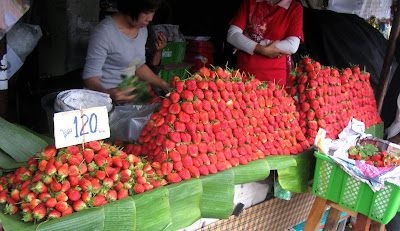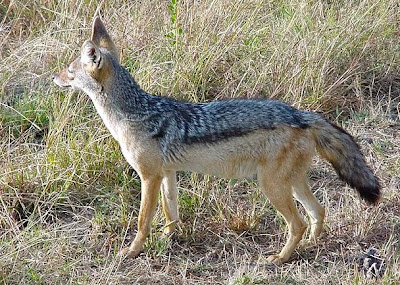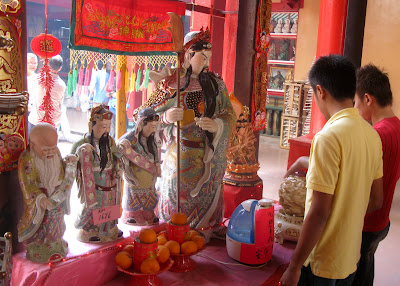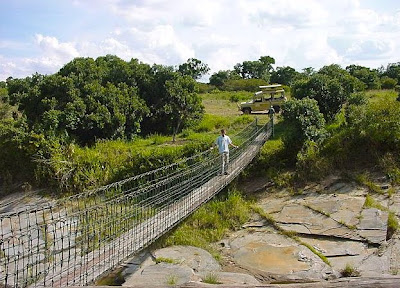
Thursday, March 24, 2011
Wandering the Streets
You encounter some pretty unusual sights when wandering around a foreign city. But they may only be unusual to you.


What to eat in Chiang Mai
 Chiang Mai strawberries. What strawberries used to taste like in the U.S.
Chiang Mai strawberries. What strawberries used to taste like in the U.S. Chiang Mai, like many cities, has food items that are specialties of the area. While there are plenty of restaurants to satisfy the tourist's palate, there are certain local items not to be missed.
Chiang Mai, like many cities, has food items that are specialties of the area. While there are plenty of restaurants to satisfy the tourist's palate, there are certain local items not to be missed.  One of these dishes is Northern Thai Khao Soi (curry noodle soup). The mild thick curry soup is usually served with chicken, or some other meat, and made with egg noodles. Originally from Burma, it has been adapted and modified by the Thais and has become a staple in Chiang Mai.
One of these dishes is Northern Thai Khao Soi (curry noodle soup). The mild thick curry soup is usually served with chicken, or some other meat, and made with egg noodles. Originally from Burma, it has been adapted and modified by the Thais and has become a staple in Chiang Mai. It generally contains red curry paste, phom kari (mild Thai yellow curry powder), garlic, coconut milk, ground pork, turmeric, sugar, lime juice, and stock. Accompaniments include chopped shallots, pickled cabbage (phak kaat dong) and lime wedges.
Sausages are quite popular in Thailand but Sai Oua is unique to Northern Thailand. It's a drier sausage made with pork, garlic, coriander, lime juice, lemon grass, galangal powder, shallot, shrimp paste, and chili peppers.
I would never recommend making sausages on your own, unless you're like our friend Pic back home who does it routinely. And he does a killer Sai Oua.
It's all safe to eat and always a great bargain. Above is a street vendor dishing up Pad Thai for a mere 20 baht (65 cents) per serving.
So when in Thailand, and especially in Chiang Mai, try the street food.
What is Happening to KL?
 The Petronas Towers put Kuala Lumpur on the 21st century map. The twin towers were the tallest buildings in the world between 1998 and 2004 when it was surpassed by Taipei 101. They remain the tallest twin buildings in the world today.
The Petronas Towers put Kuala Lumpur on the 21st century map. The twin towers were the tallest buildings in the world between 1998 and 2004 when it was surpassed by Taipei 101. They remain the tallest twin buildings in the world today. Building in many of the major cities of Asia has become a boom and in KL the massiveness of the Petronas Towers is slowly being lessened by buildings sprouting up all around them.
Building in many of the major cities of Asia has become a boom and in KL the massiveness of the Petronas Towers is slowly being lessened by buildings sprouting up all around them. The Satay Truck.
The Satay Truck. Malls are popping up more and more around the central business areas, and they are packed with shoppers.
Malls are popping up more and more around the central business areas, and they are packed with shoppers.Some complain that KL is slowly but surely going down the same path as Singapore with glitzy malls. Hopefully this will not be the case. Yes, there are malls in KL but nowhere near what Singapore's Orchard Road has become.
KL is becoming a much more modern city. It's people are multi-ethnic, diverse, and progressive.
 Malaysia is a country where Muslims are a majority. Not specifically in KL where non-muslim ethnic Chinese are the majority. But everyone gets along together here.
Malaysia is a country where Muslims are a majority. Not specifically in KL where non-muslim ethnic Chinese are the majority. But everyone gets along together here.We'll miss Japan
 Our winter trips to warmer climates in Southeast Asia and Australia usually have us heading home in April, and occasionally we choose to spend a few weeks in Japan before returning home. This was our plan for the winter trip this year until the devastation caused by the massive earthquake just off the northern Japanese coast changed our plans.
Our winter trips to warmer climates in Southeast Asia and Australia usually have us heading home in April, and occasionally we choose to spend a few weeks in Japan before returning home. This was our plan for the winter trip this year until the devastation caused by the massive earthquake just off the northern Japanese coast changed our plans.We'll miss being in Japan this spring. The cherry blossoms will still be in bloom and the people of Japan will manage to get on with their lives.
We wish them all the best.
On the Equator in Africa
 If you've been on Safari in Kenya, you probably had your picture taken here at Nanyuki.
If you've been on Safari in Kenya, you probably had your picture taken here at Nanyuki.It's a popular pit stop between camps, complete with a shop where you can pick up all the souvenirs you need.
 On the way to the Blixen compound in Nairobi we stopped to feed the giraffes at the Nairobi Giraffe Center. We were told not to tease them with the Purina Giraffe Chow we were given to feed them with. Just place some pellets in the palm of your hand and reach out to them. They will gently lap them off your palm leaving all kinds of slime for you to wipe off. But Alan had to tease them, holding pellets with a closed fist. He was swiftly met with a Giraffe head-butt, knocking him to the ground.
On the way to the Blixen compound in Nairobi we stopped to feed the giraffes at the Nairobi Giraffe Center. We were told not to tease them with the Purina Giraffe Chow we were given to feed them with. Just place some pellets in the palm of your hand and reach out to them. They will gently lap them off your palm leaving all kinds of slime for you to wipe off. But Alan had to tease them, holding pellets with a closed fist. He was swiftly met with a Giraffe head-butt, knocking him to the ground. We began our twenty day, seven camp safari in East Africa in Nairobi. The city is somewhat of a chaotic mess but much of it is only on the surface. After a night in a posh hotel in the middle of the city we made our way to our first safari destination.
We began our twenty day, seven camp safari in East Africa in Nairobi. The city is somewhat of a chaotic mess but much of it is only on the surface. After a night in a posh hotel in the middle of the city we made our way to our first safari destination. Masai are often hired by the camps to guard against roving animals. Never mind that humans are the ones encroaching on their graze lands.
Masai are often hired by the camps to guard against roving animals. Never mind that humans are the ones encroaching on their graze lands. Safaris in East and South Africa are pretty well organized. The infrastructure for safaris has been laid down and fine tuned through the years. A well know saying is "no problem". If there is a glitch, and there usually is, things will be remedied swiftly.
Safaris in East and South Africa are pretty well organized. The infrastructure for safaris has been laid down and fine tuned through the years. A well know saying is "no problem". If there is a glitch, and there usually is, things will be remedied swiftly.Your car is not here. No Problem. I'll call and they will send another car.
The airport runway is full of wild animals. No Problem. We'll buzz the runway a couple of times with our plane and they will scatter off.
 A tented accommodation in the "jungles of Africa". Sounds rough and primitive but far from it. This tent had regular beds, running water, a walk thru shower, and a cast iron bath tub on the attached deck.
A tented accommodation in the "jungles of Africa". Sounds rough and primitive but far from it. This tent had regular beds, running water, a walk thru shower, and a cast iron bath tub on the attached deck. We were encouraged to leave the flaps on the tent open during the night but we said no thanks. Our neighbors did. No rouge elephants. Only a few stray bats came flying in.
Wednesday, March 23, 2011
East Africa Safari
 A lonely male elephant.
A lonely male elephant. The male elephant, like many other animals of his sex, are destined to being solitary roamers in their old age. Having outlived his usefulness as a breeder and protector, he lives out his life alone.
Elephants that live out their years free from predators (mainly humans) usually die of starvation. Their teeth eventually wear down to the point where they can no longer chew their food properly.
 A young leopard practicing his/her climbing. After capturing prey, leopards usually drag them up trees where they are relatively free to consume their rewards free from other animals looking for an easy meal.
A young leopard practicing his/her climbing. After capturing prey, leopards usually drag them up trees where they are relatively free to consume their rewards free from other animals looking for an easy meal.
 Reticulated Giraffe, the tallest animal on the planet. It can reach a height of 19 feet and weigh up to 2600 pounds. Even though the giraffe's neck can be as long as eight feet, it still only has seven bones, the same number of bones in the human neck.
Reticulated Giraffe, the tallest animal on the planet. It can reach a height of 19 feet and weigh up to 2600 pounds. Even though the giraffe's neck can be as long as eight feet, it still only has seven bones, the same number of bones in the human neck. Hippos are the third largest land mammals, after the Elephant and Rhino, and kill more humans than any other of the wild animals in Africa. Although some believe it's a toss-up between the Rhino and Hippo for second largest.
Hippos are the third largest land mammals, after the Elephant and Rhino, and kill more humans than any other of the wild animals in Africa. Although some believe it's a toss-up between the Rhino and Hippo for second largest.The word Hippopotamus means "water horse" and if you've ever "smelled" them at the zoo, that's precisely how they smell in the wild. They love to wallow in groups of 15 or more in muddy pools during the day and the smell certainly gets ripe after a while.
 The African Lion, although easily spotted in the game parks and reserves of Africa are an endangered species. Some estimates put the current wild population at less than 20,000.
The African Lion, although easily spotted in the game parks and reserves of Africa are an endangered species. Some estimates put the current wild population at less than 20,000.
 Above are Burchell's Zebra or common plains zebras of Africa. They are more closely related to the horse than the Grevy's Zebras, (pictured below) who are more closely related to the wild ass.
Above are Burchell's Zebra or common plains zebras of Africa. They are more closely related to the horse than the Grevy's Zebras, (pictured below) who are more closely related to the wild ass. The endangered Grevy's Zebras remain only in the northern sections of Kenya and south eastern Ethiopia today. They are larger and longer legs than the Burchell's Zebra, a stripe-free belly and round ears.
The endangered Grevy's Zebras remain only in the northern sections of Kenya and south eastern Ethiopia today. They are larger and longer legs than the Burchell's Zebra, a stripe-free belly and round ears.A third species of Zebra, Equus Zebras (also know as the mountain Zebra), resides in the southern and southwestern portions of Africa.
Zebras usually precede the Wildebeests during the great migration in the Serengeti and Masai Mara. They would trim the tall grasses and the Wildebeests would follow, digging into the short grasses.
Subscribe to:
Comments (Atom)
.jpg)




























